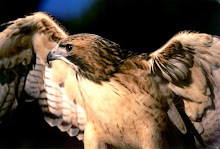 The phone rang late two nights ago. It was David B., one of our avian caretakers, who had driven right over a lump in the road, realizing at the last minute that it was an injured owl. He stopped, gathered up the bird, and was anxious to get medical care for the stunned owl. As I set about making calls to find the nearest person, he called back again. This time he reported that he didn't think there was anything wrong with this owl. Apparently when he got the owl home and was attempting to put it into a box, the owl wriggled free and led David on a merry chase throughout his house. Still, I knew that the owl would need to be examined by a wildlife rehabilitator prior to release to ensure there were no underlying problems. David and owl arrived at my home about an hour later, with the little screecher secured in a well-taped cardboard box.
The phone rang late two nights ago. It was David B., one of our avian caretakers, who had driven right over a lump in the road, realizing at the last minute that it was an injured owl. He stopped, gathered up the bird, and was anxious to get medical care for the stunned owl. As I set about making calls to find the nearest person, he called back again. This time he reported that he didn't think there was anything wrong with this owl. Apparently when he got the owl home and was attempting to put it into a box, the owl wriggled free and led David on a merry chase throughout his house. Still, I knew that the owl would need to be examined by a wildlife rehabilitator prior to release to ensure there were no underlying problems. David and owl arrived at my home about an hour later, with the little screecher secured in a well-taped cardboard box.All was well until about 5:30 a.m., when I gathered up little owl, huddled in the corner of his box to give life nourishing fluids. Same scenario: owl wriggles free, flies all over my house, and finally gets chased into the bathroom (where the kestrel sleeps at night). Whew! Owl seems fine to me too, but I know the drill. It's off to a rehabilitator for a better evaluation.
So, yesterday, I took little owl to the office where Kristin and Peggy are both wildlife rehabilitators (I am only an emergency back-up for the real thing - sort of like a bird EMT). Kristin drew the short straw and took Little Owl out of the carrier for evaluation. A strong sense of deja vu came over me. Sure enough, Little Owl wriggled free and was free-flying in our office, at one point perching atop the coat tree right in front of the photo of our educational screecher. Ron K. snapped this photo, and then it was off again. Did you know that a screecher can hang upside down from the ceiling tiles? Fortunately, we have large nets in our office for the precise purpose of catching injured birds.
In the case of Little Owl, the odds are excellent for release, probably within a day or two. However, it does graphically illustrate the power of an observant human. Had David not come upon Little Owl at that precise moment, the next car may have created road kill instead of saving a life! Thank you David!










